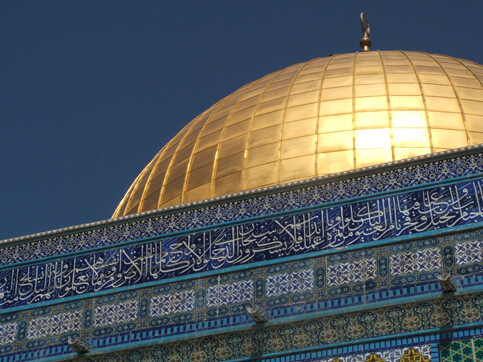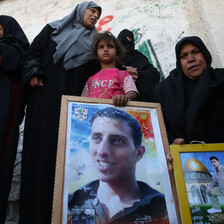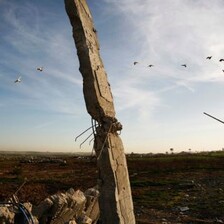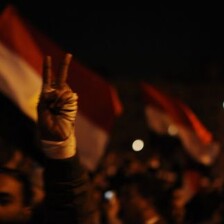Gaza Strip 11 May 2010

The Dome of the Rock in Jerusalem’s Haram al-Sharif. (Maureen Clare Murphy)
I always imagined my own version of the book 1,000 Places To See Before You Die, where the 1,000 places would be replaced by just one place of my choice. In terms of geographic proximity, that place requires no transatlantic flights. It requires no light backpacks and comfortable tennis shoes. Nor does it require a camera with lots of memory space, because I am not going to “visit” (another term that needs to be replaced in the new book), nor am I going as a tourist. The place would also — hypothetically — require no visas or permits. But what was stopping me from visiting this one place, and why has it always been on my “before I die” list, if it’s that easy to access?
My one place is al-Quds, or Jerusalem. In a utopian world, I would be able to visit the city at my leisure, given that it is only an hour and a half drive away from where I live in Gaza City. I grew up contemplating the moment I would see Jerusalem, until I graduated from the American University in Cairo and was promised by my parents that they might be able to make the necessary arrangements (a paper permit) for me to visit the holy city. After bidding farewell to Cairo, I went to Amman and then crossed the border to Jericho in the West Bnk. My father and I then drove to Ramallah — my first time there — where we spent the night. I couldn’t sleep at all, as my anticipation reached its peak. Besides my usual thoughts about what the city was like, how it sounded and smelled, how I would feel once finally reached my destination, I was wondering whether I would be lucky enough to be allowed into the city in the first place.
Morning coffee and a rooftop view of the city of Ramallah marked the beginning of one of the longest, yet most memorable days of my life, 11 March. We took off to Jerusalem. At the first checkpoint I was immediately asked for my permit. The soldier peeked into the car and shouted something in Hebrew. Even though I understood what he said, thanks to my very basic skills in Hebrew, I told him in Arabic that I could only speak Arabic. Naturally, both my attitude and permit were rejected, and we were asked to drive back.
We had to try another checkpoint: the infamous Qalandiya crossing. Abu Fathi, the driver, told me to leave the car and take nothing but my green ID card and my permit. As I stood in the queue, a very old and feeble man was stuck in a very small turnstile (these gates are built in such a way to deliberately humiliate those crossing them, like this older man). No one was able to help the man, and he was too weak to let go of his cane. His family looked helplessly from behind us; all they were able to do was plea for someone to help him. But no one was able to help him, as the soldiers hidden behind the windows would shout through the loudspeakers at anyone who would cross the line. The soldiers wouldn’t even open the door that was specifically intended for disabled persons. Eventually, someone came from the other side, took the older man’s cane, and then helped him walk through the gate.
By then, emotions were running high. When my turn came and I walked through the gate, all I had was my phone and my documents. I went to face the soldiers sitting behind the window. Just in case her loud, patronizing voice wasn’t heard well enough, loudspeakers were placed on either side of the window to emphasize her unclear Hebrew commands. She shouted and ordered me to walk back through the detector and to place my phone in a tray, just to make sure it wasn’t a bomb. When I went back to the window, she shouted for my permit. With a very disgusted look on my face, I put it against the window for her to admire. It was brief, and for that I’m grateful.
On the way to Jerusalem, after crossing the checkpoint, we enjoyed the beautiful landscape even though there was worse to come. Israel’s apartheid wall stood like a knife cutting through the beautiful landscape and up towards the sky. It seemed so out of place, this ugly, alien gray wall. Right next to, and protected by it, were the countless settlements — equally alien and out of place, like an array of red Lego pieces — they fit nowhere but in their original box.
Once in Jerusalem, we walked to Bab al-Amoud, or Damascus Gate, one of the few gates to the Old City that the Israeli occupation forces haven’t closed (although recent reports indicate that closing the gate is on the Israeli government’s agenda). The smell, the victory songs, the people, the anger, the frustration, the breeze, the tourists, the rabbis, the children, the gloom, the creepy mixture of silence and noise, the beauty, the old, the new, the almonds, the za’tar (thyme), the holiness, the alien, the familiar. None of it made sense, none of it registered. Why was the familiar — smell, sights, people, noise — mixed with the very alien? Why was the souvenir store selling “Don’t Worry America — Israel is Behind You,” “I love you, Palestine” and “Peace in the Middle East?! Hahaha” t-shirts in the same stall?
However, none of these thoughts or questions concerned me when we finally arrived at the checkpoint to al-Haram al-Sharif, or the Noble Sanctuary. The soldier said I had to leave my camera with one of the shop owners, in case I planned on filming the soldiers inside the sanctuary. I protested this ridiculous argument, and explained that I had no intention or desire to film soldiers inside, stating bluntly, “Why on Earth would I want to do that!” He gave up and we went in.
I saw it. It was so close to me, as close as it has always been to my heart. My eyes could see nothing but it, and my heart was pounding with joy. My mind wouldn’t accept it — it seemed so unreal, so close yet so far. Was I really standing in front of the Dome of the Rock, after 20 years of dreaming? My eyes and heart answered “yes,” but my mind treated it like another daydream. As I went up the holy stairs, the Dome of the Rock ascended along, and so did my love, my awe, my deep sorrow, and my greed: before I even touched the holy mosque, I found myself wondering when our next encounter might be.
Walking towards the mosque, my steps were a weird mix of heavy and slow, yet excited and enthralled and similar to skipping. My mind was sending slow signals to my feet, announcing that our long-awaited destination had finally been reached. The sight in front of me was like a flood that ran through the archives of my memory, replacing the image, smell, sound or feeling of everything I had seen before that I considered to be beautiful. It irreversibly redefined my knowledge of beauty.
As I proceeded to enter the holy mosque, my eyes took the lead. It was as if my eyes were walking around inside the mosque, not wanting to stop or to take a break, they kept walking and walking, trying to register every beautiful detail as if they wanted to make sure that they could always review them later. When I finally touched the mosque, my mind came to peaceful terms with my awed heart. There was so much beauty to be observed and to learn: the beauty of the interior, of the call to prayer, of the people, the place, the smell of the Rock from which the Prophet Muhammad ascended to heaven, and finally, the beauty of everything that’s holy.
I will never forget my first prayer in the Dome of the Rock, engulfed by the exotic and holy smell: I asked God to grant this opportunity to visit and pray at the mosque to every person who is denied the opportunity. I repeated the same prayer when I went to the al-Aqsa Mosque, equally beautiful and breathtaking, but even more saddening and worrying. Abu Fathi walked me through the Marawani tunnel under the mosque, and showed me exactly where the threat is located. In 1996, the Israeli authorities began digging an “archaeological tunnel” under the Haram al-Sharif compound for tourists in conjunction with Jewish extremists who seek to recunstruct a “Third Temple” in the place of the mosques. It was chilling to see the vivid cracks in the columns holding up the foundations of the mosque.
It was then time to leave Jerusalem. After enjoying a delicious falafel with hummus sandwich, we walked out of Bab al-Amoud and into the car. As we drove out of the city, we stopped at certain hilltops to take photographs of beautiful views, such as the Dome of the Rock and al-Aqsa, or the Orthodox Church of Mary Magdalene. The city seemed so harmonious, yet so tense.
We picked my father up from Ramallah, and then drove to Jaffa — a city that once bloomed with its Palestinian heritage and population. Jaffa, another coastal city, reminded me so much of Gaza. Its streets spoke of a great history and a great people, but its present shows a suppression of the city’s heritage and its Palestinian inhabitants. I have always longed for the day when I would see Jaffa, the birthplace and hometown of my late grandmother.
As we were returning to Gaza, my father explained, “I’m only able to tell you very few things about the roads, cities and villages that we’re driving through. Why? Because I’m not allowed to travel through them as often as I would like. If your late grandfather was with us in the car, he would’ve been able to tell you the names of every single street that we saw, and even the names of the families living in it.”
He wondered aloud: “What will you be able to tell your children?”
We drove south towards the Erez crossing, which was closed by the time we arrived. For a moment, it seemed like we would have to spend the night in the car next to the crossing, because my two-day permit would expire the next day. However, a number of individuals were trying to cross the border, and after a lot of pressure, the gate opened and we were finally let through.
As we drove home, I realized that I had never been so happy returning to Gaza, the prison I like to call home. I didn’t go back to Gaza through Rafah via Egypt, or via Jordan. I went to Gaza after praying in Jerusalem in the morning, and passing through Ramallah, Tel-Rabia and Jaffa in the afternoon. I loved the idea, I loved how I spent 11 March, it was a day when I felt that I belonged to a beautiful country called Palestine — one that I could actually see. I felt so grateful, yet so sad, for I know that millions of Palestinian refugees can only dream of a day like 11 March. Yet before that day it was no more than a dream for me.
I am now back in the world’s largest prison, and I have no idea when I will be allowed out again. But my visit to Jerusalem will allow me to be happy for a long time to come and I know deep in my heart that the day will come when I will repeat this trip, and go to even more cities. I know deep in my heart that my children will grow to know more, and love Palestine more than I ever will — just like my father taught me to, and just like his own father taught him to. After all, I didn’t care that a two-day permit that took more than three months to be issued was required, but I did care to keep in mind that as much as my love and awe increased for this country, so did my obligation to do more for it, and to make sure that in the future, no one would ever need a permit to make the same trip.
Yasmeen El Khoudary is a 20-year-old Palestinian, born and raised in Gaza City. While in Gaza, she graduated from the American International School (AISG) which was bombed during Israel’s invasion of Gaza of winter 2008-09. She is a recent graduate of the American University in Cairo.





